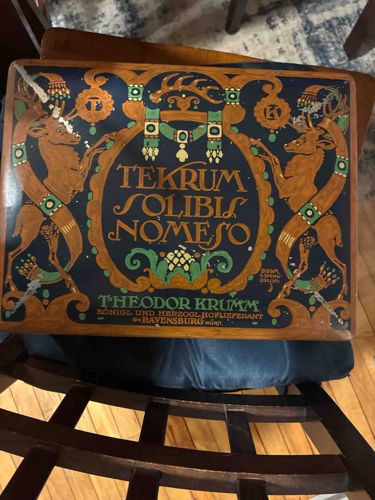
Theodor Krumm 'Tekrum Solibls Nomeso' Display Tray
This item is a decorative wooden display tray, featuring a vibrant and intricate Art Nouveau-style design. The tray is rectangular with slightly rounded corners, typical of early 20th-century serving or display pieces. The primary color scheme consists of a deep navy blue background, contrasting with rich ochre/light brown, forest green, and hints of light blue and white. The central motif includes two stylized deer, facing inwards, each with large antlers that blend into the surrounding decorative elements. They are adorned with patterned cuffs and collars in anticipation of a grand feast, displaying an anthropomorphic quality. The main text, 'TEKRUM SOLIBLS NOMESO', is prominently displayed in a custom Art Nouveau font within an oval border, suggesting a brand name or motto. Below this, smaller text identifies 'THEODOR KRUMM KÖNIGL UND HERZOGL. HOFLIEFERANT VON RAVENSBURG württ.', indicating that Theodor Krumm was a royal and ducal purveyor from Ravensburg, Germany. This company was known for its biscuits and baked goods, making this likely a promotional or serving tray for their products. The craftsmanship suggests a stenciled or printed design on wood, possibly with a lacquer or shellac finish to protect the artwork. There are visible signs of wear, including scratches and chips in the design, particularly evident on the antlers of the left deer and scattered across the surface, revealing the lighter wood beneath. This wear is consistent with age and use. The edges of the tray also show some scuffing. The overall artistic style points to the Art Nouveau period, likely dating from the late 19th to early 20th century (circa 1890-1920), a time when decorative arts embraced organic forms, intricate lines, and flat blocks of color. The detailed imagery, the specific typography, and the incorporation of flora and fauna motifs are all hallmarks of this period. The quality of the design is high, with attention to detail in the graphical elements, suggesting it was created by a skilled artist or graphic designer of the era. The tray itself appears to be of solid wooden construction, contributing to its durability and perceived quality. The unique aspect lies in its fusion of commercial advertising with fine graphic design from a specific historical art movement.
AI-Generated Appraisal Disclaimer
Estimated Value
$500-800
Basic Information
Category
Decorative Tray
Appraised On
November 28, 2025
Estimated Value
$500-800
Item Description
This item is a decorative wooden display tray, featuring a vibrant and intricate Art Nouveau-style design. The tray is rectangular with slightly rounded corners, typical of early 20th-century serving or display pieces. The primary color scheme consists of a deep navy blue background, contrasting with rich ochre/light brown, forest green, and hints of light blue and white. The central motif includes two stylized deer, facing inwards, each with large antlers that blend into the surrounding decorative elements. They are adorned with patterned cuffs and collars in anticipation of a grand feast, displaying an anthropomorphic quality. The main text, 'TEKRUM SOLIBLS NOMESO', is prominently displayed in a custom Art Nouveau font within an oval border, suggesting a brand name or motto. Below this, smaller text identifies 'THEODOR KRUMM KÖNIGL UND HERZOGL. HOFLIEFERANT VON RAVENSBURG württ.', indicating that Theodor Krumm was a royal and ducal purveyor from Ravensburg, Germany. This company was known for its biscuits and baked goods, making this likely a promotional or serving tray for their products. The craftsmanship suggests a stenciled or printed design on wood, possibly with a lacquer or shellac finish to protect the artwork. There are visible signs of wear, including scratches and chips in the design, particularly evident on the antlers of the left deer and scattered across the surface, revealing the lighter wood beneath. This wear is consistent with age and use. The edges of the tray also show some scuffing. The overall artistic style points to the Art Nouveau period, likely dating from the late 19th to early 20th century (circa 1890-1920), a time when decorative arts embraced organic forms, intricate lines, and flat blocks of color. The detailed imagery, the specific typography, and the incorporation of flora and fauna motifs are all hallmarks of this period. The quality of the design is high, with attention to detail in the graphical elements, suggesting it was created by a skilled artist or graphic designer of the era. The tray itself appears to be of solid wooden construction, contributing to its durability and perceived quality. The unique aspect lies in its fusion of commercial advertising with fine graphic design from a specific historical art movement.
Related Tags
Explore similar items and categories:
Get Your Items Appraised
Instant estimates of your treasures with AI-powered instant appraisals